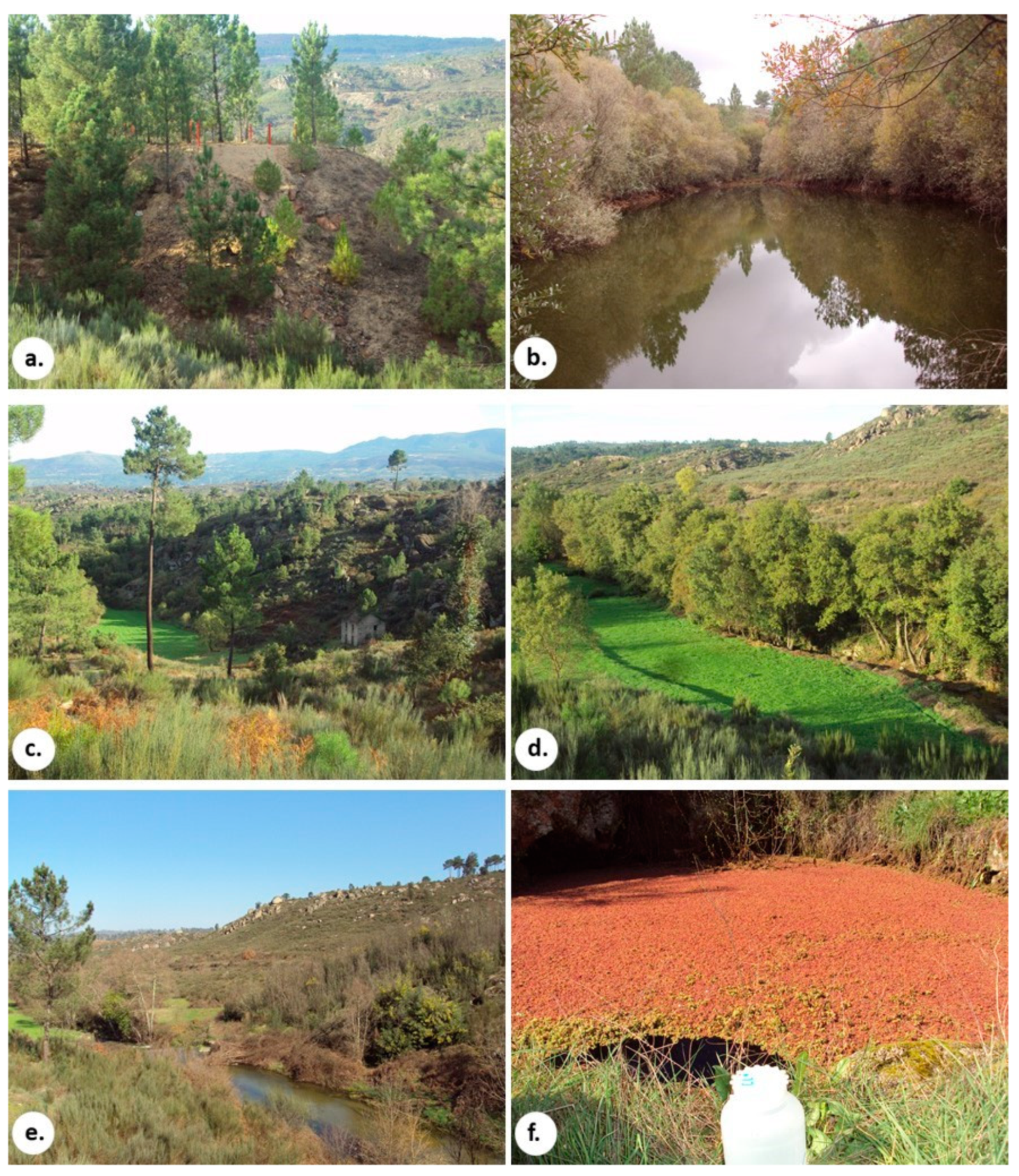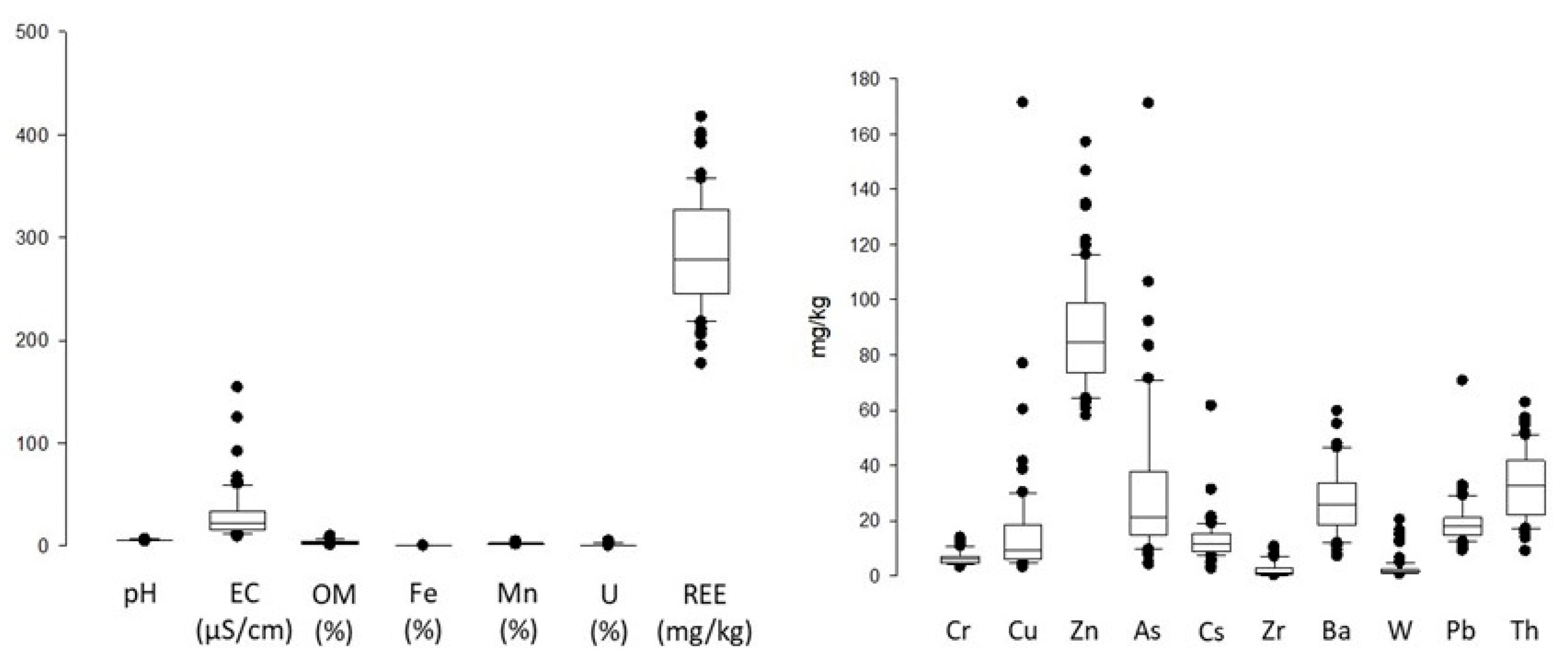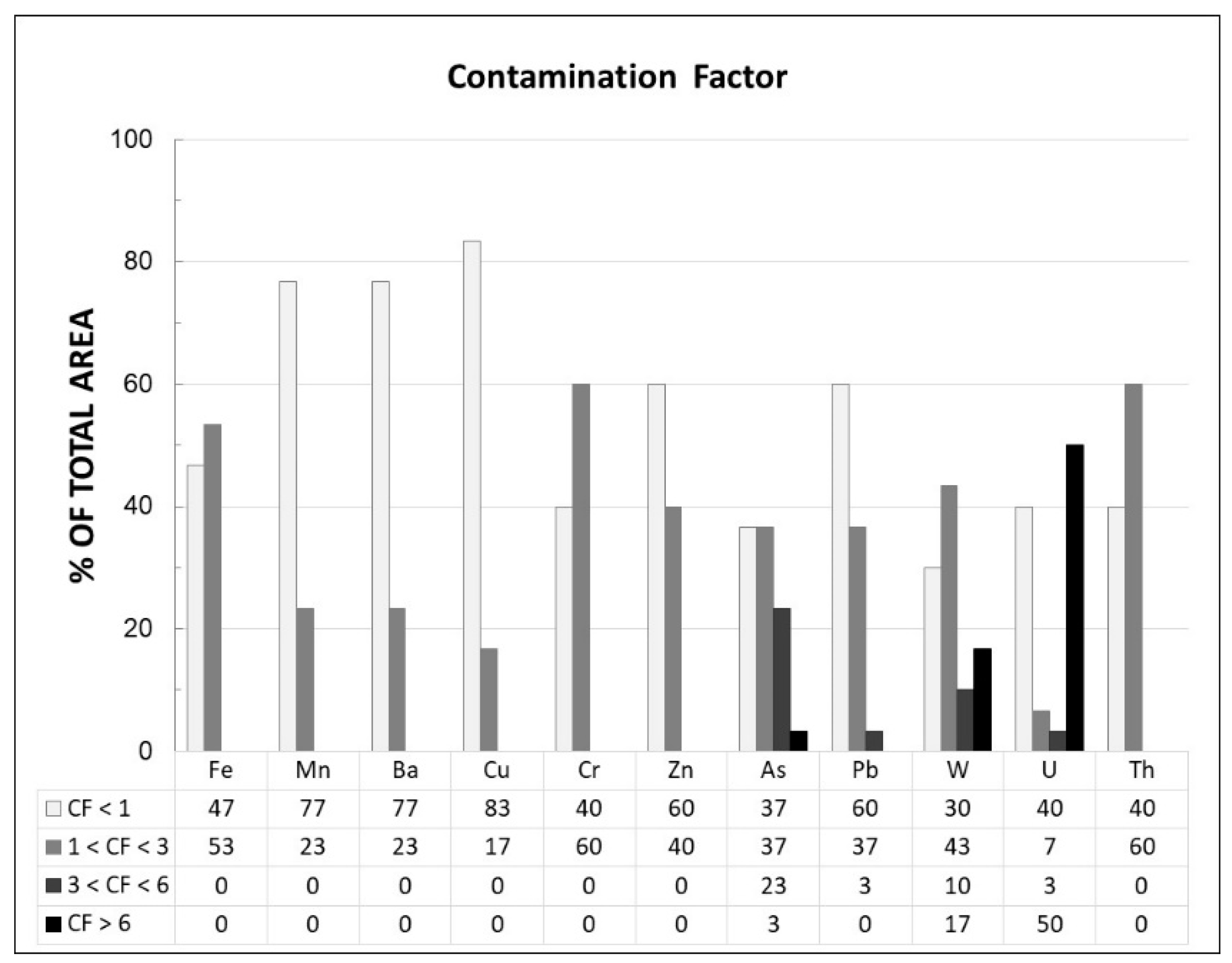Spatial Mobility of U and Th in a U-enriched Area (Central Portugal)
Abstract
:1. Introduction
2. Materials and Methods
3. Results and Discussion
3.1. Geochemistry of Stream Sediments and Soils
3.2. Contamination Indexes
4. Conclusions
Author Contributions
Funding
Acknowledgments
Conflicts of Interest
References
- Milvy, P.; Cothern, C.R. Scientific Background for the Development of Regulations for Radionuclides in Drinking Water. In Radon, Radium and Uranium in Drinking Water; Cothern, C.R., Rebers, P., Eds.; Lewis Publishers: Chelsea, MI, USA, 1990; pp. 1–16. [Google Scholar]
- EFSA—European Food Safety Authority. Uranium in food tuffs, in particular mineral water. Scientific opinion of the panel on contaminants in the food chain. EFSA J. 2009, 1018, 1–59. [Google Scholar]
- Antunes, I.; Neiva, A.; Albuquerque, M.; Carvalho, P.C.S.; Santos, A.C.T.; Cunha, P.P. Potential toxic elements in stream sediments, soils and waters in an abandoned radium mine (central Portugal). Environ. Geochem. Health 2017, 40, 521–542. [Google Scholar] [CrossRef] [Green Version]
- Arogunjo, A.; Höllriegl, V.; Giussani, A.; Leopold, K.; Gerstmann, U.; Veronese, I.; Oeh, U. Uranium and thorium in soils, mineral sands, water and food samples in a tin mining area in Nigeria with elevated activity. J. Environ. Radioact. 2009, 100, 232–240. [Google Scholar] [CrossRef]
- Dittmar, M. The end of cheap uranium. Sci. Total Environ. 2013, 461, 792–798. [Google Scholar] [CrossRef]
- Falck, W.E. The Long-Term Safety of Uranium Mine and Mill Tailings Legacies in an Enlarged EU; JCR Scientific and Technical Report #49047; Office for the Official Publications of the European Communities: Luxembourg, Germany, 2008; p. 33. [Google Scholar]
- Raeva, D.; Slavov, T.; Stoyanova, D.; Zivčič, L.; Tkalec, T.; Rode, Š. Expanded Nuclear Power capacity in Europe, Impact of Uranium mining and alternatives. EJOLT Rep. 2014, 12, 129. [Google Scholar]
- World Nuclear Association. Supply of Uranium. Available online: http://www.world-nuclear.org/info/inf75.html2015 (accessed on 24 September 2020).
- Brugge, D.; Buchner, V. Health effects of uranium: New research findings. Rev. Environ. Health 2011, 26, 231–249. [Google Scholar] [CrossRef]
- Cuvier, A.; Panza, F.; Pourcelot, L.; Foissard, B.; Cagnat, X.; Prunier, J.; Van Beek, P.; Souhaut, M.; Le Roux, G. Uranium decay daughters from isolated mines: Accumulation and sources. J. Environ. Radioact. 2015, 149, 110–120. [Google Scholar] [CrossRef] [PubMed]
- Kozak, K.; Mazur, J.; Vaupotič, J.; Grządziel, D.; Kobal, I.; Omran, K.M. The potential health hazard due to elevated radioactivity in old uranium mines in Dolina Białego, Tatra Mountains, Poland. Isot. Environ. Health Stud. 2013, 49, 274–282. [Google Scholar] [CrossRef]
- Neiva, A.; Carvalho, P.C.S.; Antunes, I.; Silva, M.M.V.G.; Santos, A.; Pinto, M.M.S.C.; Cunha, P.P. Contaminated water, stream sediments and soils close to the abandoned Pinhal do Souto uranium mine, central Portugal. J. Geochem. Explor. 2014, 136, 102–117. [Google Scholar] [CrossRef] [Green Version]
- Foulkes, M.; Millward, G.E.; Henderson, S.; Blake, W. Bioaccessibility of U, Th and Pb in solid wastes and soils from an abandoned uranium mine. J. Environ. Radioact. 2017, 173, 85–96. [Google Scholar] [CrossRef] [Green Version]
- Villa, M.; Manjón, G.; Hurtado-Bermúdez, S.; García-Tenorio, R.; Villa-Alfageme, M. Uranium pollution in an estuary affected by pyrite acid mine drainage and releases of naturally occurring radioactive materials. Mar. Pollut. Bull. 2011, 62, 1521–1529. [Google Scholar] [CrossRef]
- White, P.A.F.; Smith, S.E. Review of uranium ore processing research. J. Br. Nucl. Energy Soc. 1969, 8, 93–102. [Google Scholar]
- Kaksonen, A.H.; Lakaniemi, A.-M.; Tuovinen, O.H. Acid and ferric sulfate bioleaching of uranium ores: A review. J. Clean. Prod. 2020, 264, 121586. [Google Scholar] [CrossRef]
- Abrahams, P.W. Soils: Their implications to human health. Sci. Total Environ. 2002, 291, 1–32. [Google Scholar] [CrossRef] [Green Version]
- IPMA. Instituto Português do Mar e da Atmosfera. Clima de Portugal Continental. Available online: https://www.ipma.pt/pt/oclima/normais.clima/ (accessed on 16 August 2020).
- SNIRH, Sistema Nacional de Informação de Recursos Hídricos. Available online: https://snirh.apambiente.pt/index.php?idMain=1&idItem=1.1 (accessed on 10 September 2020).
- British Standard (BS) 7755. Soil Quality, Part 3. Chemical Methods, Section 3.2. Determination of pH; ISSO 10390; British Standards Institution: Glasgow, UK, 1995; p. 1. [Google Scholar]
- British Standard (BS) 7755. Soil Quality, Part 3. Chemical Methods, Section 3.4. Determination of Specific Electrical Conductivity; ISSO 11265; British Standards Institution: Glasgow, UK, 1995; p. 1. [Google Scholar]
- User Manual. Jobin Yvon ICP Spectometers. Version 3.0; Reference: 31088486. 2001, pp. 20–23. Available online: https://www.horiba.com/cn/scientific/products/optical-spectroscopy/newsletter/october-2009/find-out-about-our-latest-spectroscopy-software-synerj (accessed on 13 October 2020).
- Antunes, I.; Albuquerque, M.; Roque, N. Spatial environmental risk evaluation of potential toxic elements in stream sediments. Environ. Geochem. Health 2018, 40, 2573–2585. [Google Scholar] [CrossRef]
- Antunes, I.; Gomes, M.; Neiva, A.; Carvalho, P.; Santos, A. Potential risk assessment in stream sediments, soils and waters after remediation in an abandoned W > Sn mine (NE Portugal). Ecotoxicol. Environ. Saf. 2016, 133, 135–145. [Google Scholar] [CrossRef]
- Håkanson, L. An Ecological Risk Index for aquatic pollution control—A sedimentological approach. Water Res. 1980, 14, 975–1001. [Google Scholar] [CrossRef]
- Wenyl, H.; Fengru, H.; Jingsheng, C. Comparative study of assessment method for river particulate heavy metal pollution. Sci. Geogr. Sinca 1997, 17, 81–86. [Google Scholar]
- Vreča, P.; Dolenec, T. Geochemical estimation of copper contamination in the healing mud from Makirina Bay, central Adriatic. Environ. Int. 2005, 31, 53–61. [Google Scholar] [CrossRef]
- Karydas, C.G.; Tzoraki, O.A.; Panagos, P. A New Spatiotemporal Risk Index for Heavy Metals: Application in Cyprus. Water 2015, 7, 4323–4342. [Google Scholar] [CrossRef] [Green Version]
- Sutherland, R.A. Bed sediment-associated trace metals in an urban stream, Oahu, Hawaii. Environ. Earth Sci. 2000, 39, 611–627. [Google Scholar] [CrossRef]
- Andrews, S.; Sutherland, R.; Sutherland, R.A. Cu, Pb and Zn contamination in Nuuanu watershed, Oahu, Hawaii. Sci. Total Environ. 2004, 324, 173–182. [Google Scholar] [CrossRef]
- Ferreira, A.M.P.J. Dados Geoquímicos de Base de Sedimentos Fluviais de Amostragem de Baixa Densidade de Portugal Continental: Estudo de Factores de Variação Regional. Ph.D. Thesis, Universidade de Aveiro, Aveiro, Portugal, 2000. [Google Scholar]
- Salminen, R.; Batista, M.J.; Bidovec, M.; Demetriades, A.; De Vivo, B.; De Vos, W.; Duris, M. FOREGS Geochemical Atlas of Europe, Methodology and Maps; Part 1–526p and Part 2–690p; Geological Survey of Finland: Espoo, Finland, 2005. [Google Scholar]
- Canadian Soil Guidelines. Canadian Soil Quality Guidelines for the Protection of Environmental and Human Health; 2017; Summary tables 1–6. Available online: https://www.ccme.ca/files/ceqg/en/backup/250-081209115239.pdf (accessed on 13 October 2020).




| Accuracy | Precision | |
|---|---|---|
| Concentration Relatively to Detection Limit (DL) | ||
| <3 DL | ≤0.024 | 0.031 |
| >3 DL | ≤0.015 | 0.018 |
| pH | EC | OM | Fe | Mn | Cr | Cu | Zn | As | Cs | Zr | Ba | REE | W | Pb | Th | U | ||
|---|---|---|---|---|---|---|---|---|---|---|---|---|---|---|---|---|---|---|
| µS/cm | % | mg/kg | ||||||||||||||||
| Stream sediments_upstream | Median | 6.04 | 22.60 | 1.67 | 1.85 | 0.05 | 4.95 | 17.77 | 90.63 | 18.31 | 19.22 | 0.68 | 30.74 | 262.73 | 1.26 | 18.01 | 25.56 | 131.86 |
| Minimum | 5.99 | 12.70 | 0.79 | 1.61 | 0.03 | 4.14 | 11.48 | 81.34 | 13.70 | 17.29 | 0.34 | 23.09 | 218.30 | 1.05 | 12.98 | 20.96 | 102.48 | |
| Maximum | 6.13 | 34.20 | 2.64 | 1.98 | 0.07 | 5.58 | 21.34 | 102.08 | 22.53 | 21.42 | 0.96 | 35.40 | 327.12 | 1.62 | 22.02 | 30.26 | 182.75 | |
| St deviation | 0.08 | 10.85 | 0.93 | 0.20 | 0.02 | 0.74 | 5.46 | 10.54 | 4.43 | 2.08 | 0.31 | 6.67 | 57.09 | 0.32 | 4.61 | 4.65 | 44.25 | |
| N | 3 | |||||||||||||||||
| Stream sediments_downstream | Median | 5.92 | 55.16 | 2.59 | 1.58 | 0.03 | 9.29 | 17.01 | 108.06 | 13.24 | 8.86 | 0.49 | 30.10 | 234.19 | 2.00 | 23.15 | 18.97 | 87.70 |
| Minimum | 4.40 | 25.10 | 1.02 | 1.33 | 0.02 | 3.14 | 3.70 | 64.34 | 4.04 | 7.41 | 0.12 | 10.78 | 177.13 | 0.56 | 9.60 | 8.95 | 19.01 | |
| Maximum | 6.42 | 154.20 | 5.82 | 1.97 | 0.06 | 13.76 | 30.27 | 157.14 | 35.88 | 13.74 | 3.45 | 47.70 | 355.99 | 4.76 | 31.78 | 32.02 | 454.04 | |
| St deviation | 0.56 | 35.85 | 1.35 | 0.24 | 0.01 | 3.04 | 7.52 | 28.81 | 8.99 | 1.73 | 0.98 | 9.67 | 50.00 | 1.36 | 6.90 | 6.94 | 125.78 | |
| N | 11 | |||||||||||||||||
| Soil_background | Median | 5.36 | 23.12 | 2.99 | 1.98 | 0.05 | 6.20 | 30.84 | 91.34 | 15.34 | 25.56 | 0.93 | 39.18 | 303.98 | 1.03 | 18.43 | 38.14 | 50.14 |
| Minimum | 5.09 | 12.80 | 2.13 | 1.51 | 0.03 | 4.59 | 7.06 | 73.27 | 11.18 | 10.52 | 0.36 | 23.46 | 265.76 | 0.61 | 13.97 | 29.22 | 13.06 | |
| Maximum | 5.73 | 12.80 | 4.33 | 2.43 | 0.08 | 7.95 | 171.41 | 109.65 | 38.06 | 61.53 | 2.38 | 59.72 | 401.90 | 1.63 | 22.89 | 51.00 | 195.59 | |
| St deviation | 0.22 | 39.92 | 0.76 | 0.34 | 0.02 | 1.13 | 59.83 | 13.56 | 9.07 | 17.84 | 0.74 | 13.39 | 57.02 | 0.39 | 3.08 | 6.71 | 59.57 | |
| N | 7 | |||||||||||||||||
| Soil_mine influence | Median | 5.25 | 26.64 | 4.51 | 1.93 | 0.03 | 6.39 | 11.27 | 80.73 | 24.87 | 12.50 | 1.24 | 29.39 | 282.12 | 1.23 | 18.99 | 30.33 | 168.27 |
| Minimum | 4.71 | 10.70 | 1.81 | 1.53 | 0.02 | 3.38 | 3.07 | 57.97 | 4.68 | 3.49 | 0.23 | 12.97 | 223.56 | 0.54 | 9.08 | 15.81 | - | |
| Maximum | 5.95 | 91.80 | 9.57 | 2.53 | 0.05 | 13.36 | 41.46 | 134.86 | 60.48 | 20.52 | 9.55 | 55.00 | 417.48 | 2.93 | 32.80 | 54.80 | 1561.06 | |
| St deviation | 0.32 | 16.01 | 2.03 | 0.26 | 0.01 | 2.51 | 10.15 | 17.90 | 14.69 | 3.35 | 1.87 | 10.10 | 43.71 | 0.55 | 5.51 | 10.01 | 329.31 | |
| N | 33 | |||||||||||||||||
| Mine dumps | Median | 5.46 | 16.36 | 1.76 | 2.54 | 0.05 | 5.24 | 9.84 | 90.66 | 66.12 | 9.65 | 5.57 | 14.00 | 320.30 | 6.69 | 18.14 | 45.30 | 2318.62 |
| Minimum | 4.34 | 9.10 | 0.89 | 1.70 | 0.02 | 3.56 | 4.76 | 63.16 | 24.61 | 2.51 | 0.73 | 7.00 | 232.28 | 1.19 | 11.38 | 21.19 | 132.45 | |
| Maximum | 6.36 | 41.00 | 5.96 | 4.26 | 0.09 | 7.94 | 16.47 | 121.71 | 171.16 | 20.73 | 10.59 | 24.07 | 399.06 | 20.27 | 70.66 | 62.71 | 4540.06 | |
| St deviation | 0.57 | 8.80 | 1.45 | 0.64 | 0.01 | 1.44 | 3.37 | 13.58 | 37.66 | 4.58 | 2.71 | 4.60 | 46.65 | 6.36 | 14.25 | 10.01 | 1188.03 | |
| N | 16 | |||||||||||||||||
| Mine Dumps | Stream Sediments | |||||
|---|---|---|---|---|---|---|
| Min | Max | Med | Min | Max | Med | |
| Fe | 0.9 | 2.3 | 1.4 | 0.7 | 1.1 | 0.9 |
| Mn | 0.5 | 1.7 | 1.0 | 0.4 | 1.4 | 0.7 |
| Ba | 0.2 | 0.8 | 0.5 | 0.4 | 1.6 | 1.0 |
| Cr | 0.3 | 0.9 | 0.6 | 0.2 | 1.7 | 1.0 |
| Zn | 0.7 | 1.6 | 1.1 | 0.6 | 2.8 | 1.7 |
| Pb | 0.6 | 3.9 | 1.0 | 0.5 | 1.8 | 1.2 |
| As | 1.3 | 9.3 | 3.6 | 0.2 | 2.0 | 0.8 |
| W | 0.9 | 16.1 | 5.3 | 0.4 | 3.8 | 1.5 |
| U | 1.0 | 34.4 | 17.6 | 0.1 | 3.4 | 0.7 |
| Th | 0.8 | 2.5 | 1.8 | 0.4 | 1.3 | 0.8 |
| CD | 11.6 | 54.1 | 34.7 | 8.7 | 14.5 | 11.4 |
| Canto Lagar Area | Geochemical Atlas of Europe | |||||
|---|---|---|---|---|---|---|
| Minimum | Maximum | Median | Minimum | Maximum | Median | |
| Fe | 1.3 | 4.3 | 1.8 | 0.06 | 20.0 | 1.97 |
| Mn | 0.0 | 0.1 | 0.0 | 24.0 | 18900 | 452 |
| Cr | 3.1 | 13.8 | 5.2 | 2.0 | 1750 | 21.0 |
| Cu | 3.7 | 30.3 | 17.0 | 1.0 | 998 | 14.0 |
| Zn | 63.2 | 157.1 | 90.7 | 7.0 | 11.0 | 60.0 |
| As | 4.0 | 171.2 | 18.3 | <5 | 231.0 | 6.0 |
| W | 0.6 | 20.3 | 2.0 | <0.05 | 82.0 | 1.2 |
| Pb | 9.6 | 70.7 | 18.1 | <3 | 4880 | 14.0 |
| Th | 8.9 | 62.7 | 25.6 | <1 | 13.9 | 253 |
| U | 19.0 | 4540.1 | 131.9 | <1 | 98.0 | 2.0 |
| Canto Lagar | Geochemical Atlas of Europe | Canadian Soil Guidelines | ||||||
|---|---|---|---|---|---|---|---|---|
| Minimum | Maximum | Median | Minimum | Maximum | Median | Agricultural | Residential Parkland | |
| Fe | 1.51 | 2.53 | 1.96 | 0.1 | 15.2 | 1.96 | - | - |
| Mn | 0.02 | 0.08 | 0.04 | <10 | 6480 | 382 | - | - |
| Cr | 3.38 | 13.36 | 6.30 | 1 | 2340 | 22 | 64 | 64 |
| Cu | 3.07 | 171.41 | 21.06 | <1 | 118 | 13 | 63 | 63 |
| Zn | 57.97 | 134.86 | 86.04 | 4 | 2270 | 48 | 200 | 200 |
| As | 4.68 | 60.48 | 20.11 | 5 | 220 | 6 | 12 | 12 |
| Cs | 3.49 | 61.53 | 19.03 | <0.5 | 69.1 | 3.71 | - | - |
| Zr | 0.23 | 9.55 | 1.09 | 5 | 1060 | 231 | - | - |
| Ba | 12.97 | 59.72 | 34.29 | 10 | 1700 | 65 | 750 | 500 |
| W | 0.54 | 2.93 | 1.13 | <5 | 14 | <5 | - | - |
| Pb | 9.08 | 32.8 | 18.71 | <3 | 15 | 886 | 70 | 140 |
| Th | 15.81 | 54.8 | 34.24 | 0.3 | 75.9 | 7.24 | - | - |
| U | - | 1561.06 | 109.2 | 0.2 | 53.2 | 2.03 | 23 | 23 |
Publisher’s Note: MDPI stays neutral with regard to jurisdictional claims in published maps and institutional affiliations. |
© 2020 by the authors. Licensee MDPI, Basel, Switzerland. This article is an open access article distributed under the terms and conditions of the Creative Commons Attribution (CC BY) license (http://creativecommons.org/licenses/by/4.0/).
Share and Cite
Antunes, M.; Santos, A.; Valente, T.; Albuquerque, T. Spatial Mobility of U and Th in a U-enriched Area (Central Portugal). Appl. Sci. 2020, 10, 7866. https://doi.org/10.3390/app10217866
Antunes M, Santos A, Valente T, Albuquerque T. Spatial Mobility of U and Th in a U-enriched Area (Central Portugal). Applied Sciences. 2020; 10(21):7866. https://doi.org/10.3390/app10217866
Chicago/Turabian StyleAntunes, Margarida, António Santos, Teresa Valente, and Teresa Albuquerque. 2020. "Spatial Mobility of U and Th in a U-enriched Area (Central Portugal)" Applied Sciences 10, no. 21: 7866. https://doi.org/10.3390/app10217866








